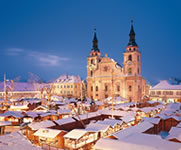
The Bergisches Land, and the 18,000-hectare nature reserve of the same name, lie between the rivers Rhine, Ruhr and Sieg. This region is part of the Rhenish-Westphalian slate mountains to the east of the Rhine and has extensive beech, oak and pine woods, lush meadows and colourful orchards. The region's settlements are charmingly tucked away in the landscape, but once discovered will seduce you with their architectural beauty. The slate-fronted and half-timbered buildings really are a magnificent sight, with their white window frames, green shutters and carved front doors, topped off with ridge turrets and elegantly sweeping front gables.
These buildings lend the picturesque towns and villages a little extra elegance. Hill ranges and rounded peaks with valleys, dams, colourful churches, old mills, stately homes, castles and palaces complete the picture. Anyone who just wants to set off and see what they find can hardly go wrong in this region which also has plenty of lakes.

The region is called the Bergisches Land after the Counts von Berg, who ruled here for hundreds of years. But some of its previous inhabitants are even better known, as you can find out on a visit to the Neander valley in the area surrounding Mettmann. This area is famous throughout the world. It is here that human history was made in 1856, when quarry workers found a human skeleton in a cave. This was later identified as prehistoric. Researchers traced this Homo sapiens neanderthalensis, or Neanderthal Man, back to 200,000 to 400,000 B.C. New, sensational finds are still being made in the area. You will find more detailed information at the Neanderthal Museum in Mettmann.
But this region also has lots to offer sports fans, whether they like messing around in or on the water or flying high. You could gallop through the countryside, take a walking tour to enjoy the scenery or explore the Bergisches Land region by motorcycle or push bike. There really is something for everyone here. A new castle, palace, stately home or historic mill is always just round the next corner as you explore. You will also discover evidence of traditional crafts and early industry. Knives and scissors from Solingen still make the city's name. The German Blade Museum shows the glittering career of these sharp steel objects.
 Skip to content
Skip to navigation
Skip to subnavigation
Skip to search
Skip to content
Skip to navigation
Skip to subnavigation
Skip to search






